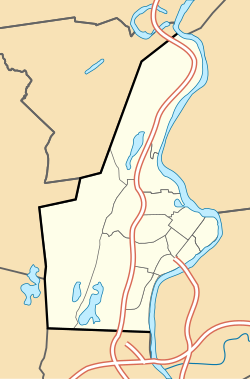Churchill | |
|---|---|
 The skyline of Churchill, with the prominent steeple of the Sacred Heart Church, the neighborhood's namesake | |
| Coordinates: 42°12′1.9836″N 72°36′54.3636″W / 42.200551000°N 72.615101000°W | |
| Country | United States |
| State | Massachusetts |
| City | Holyoke |
| Wards | 1, 2, 4 |
| Precincts | 1B, 2B, 4A |
| Area | |
| • Total | 0.26 sq mi (0.7 km2) |
| Elevation | 151 ft (46 m) |
| ZIP code | 01040 |
| Area code | 413 |
Churchill is a neighborhood in Holyoke, Massachusetts located to the south of the city center, approximately 0.5 miles (0.80 km) from downtown center.[1] Its name is a geographic portmanteau as the area was historically known as the Church Hill district prior to its extensive development in the early twentieth century.[2][3] Located at the southwestern edge of the downtown grid, the area served as housing for mill workers in the late nineteenth and early twentieth century and today contains 166 acres (67 ha) of mixed residential and commercial zoning, including a number of historical brick tenements as well as the headquarters of the Holyoke Housing Authority, Holyoke Senior Center, Churchill Homes development, and Wistariahurst at its northwestern edge.
History
editAs Holyoke grew rapidly in its first decades, a number of tenements and worker housing was constructed on the grid's south side. Seeing this growth, one Father P.J. Harkins, pastor of St. Jerome's in Holyoke Center purchased a large tract of land where Maple met Sargeant Street. Within the year the neighborhood's most prominent church, the Church of the Sacred Heart, had its cornerstone placed on the American centennial of July 4, 1876, and over the course of the next two decades a rectory and school buildings were constructed on the adjacent land.[4]
The neighborhood was previously home to one of the first developments of the Holyoke Housing Authority, Jackson Parkway, a project of 219 units built in 1943 which at one time comprised a quarter of all residential units in the area. The project soon gained a reputation for its poverty and crime and in a HUD review of the project, it was described as significantly "isolated from the economic and social fabric of the surrounding community".[5] Efforts to improve conditions were made, including the construction of a community center in 1977, now used by the Head Start program.[6]
In 1996 the Housing Authority received a $15 million grant from the HOPE VI plan to redevelop the space entirely, and by 2003 the entirety of the Jackson Parkway project was demolished. Following the development of a revitalization project, construction began in 2003 on a new housing project known as Churchill Homes, built following the concepts of new urbanism to create space more congruent with the surrounding area's developments while granting low-income households greater homeownership; of the 100 units built, 50 are federally-assisted housing units managed by the Housing Authority, while the remaining 50 are occupant-owned. The project, completed in two phases, received wide acclaim including an Citation Award for Design by the American Institute of Architect in 2002 and a 2003 Award of Merit in Housing and Community Development by the National Association of Housing and Redevelopment Officials (NAHRO).[7][8][9][10]
https://www.masslive.com/news/index.ssf/2010/09/holyokes_churchill_homes_marke.html
http://dietzarch.com/portfolio/churchill-neighborhood/
MACRIS https://archive.org/stream/storyofholyoke00harp#page/82
References
edit- ^ a b Spatial analysis of "Holyoke Neighborhoods" (PDF). Archived from the original (PDF) on 8 August 2017. Retrieved 3 Jun 2016.
{{cite web}}:|archive-date=/|archive-url=timestamp mismatch; 2 August 2017 suggested (help) - ^ "Water Board's Troubles". The Springfield Republican. Springfield, Mass. May 21, 1922. p. 10.
As a matter of equity the 'gridironing' in the Church hill district, as it used to be called, Churchill [sic], is for the benefit of taxpayers and water takers for a long term of years.
- ^ HLY.C, Massachusetts Cultural Resource Information System (MACRIS), Massachusetts Historical Commission.
- ^ "Holyoke, Mass.; Its Early Catholic History and Present Flourishing Condition". The Sacred Heart Review. Vol. II, no. 12. Boston. September 21, 1895.
- ^ https://books.google.com/books?id=iNr0wLuT8bEC&pg=PA98&dq=%22Churchill+neighborhood%22+holyoke&hl=en&sa=X&ved=0ahUKEwicy5flx5DeAhUDwFkKHRzlBFcQ6AEIUDAJ#v=onepage&q=%22Churchill%20neighborhood%22%20holyoke&f=false
- ^ "Ground broken". Springfield Union. Springfield, Mass. April 28, 1977. p. 2.
- ^ http://warehammaarchive.vt-s.net/Public_Documents/WarehamMA_Data/save/Community%20Builders%20FINAL.pdf
- ^ https://www.cityofoberlin.com/wp-content/uploads/2014/07/Moody-Nolan-TCB-Ozanne-Green-Acres-Proposal.pdf
- ^ https://www.mhp.net/writable/resources/documents/MHP-2017-Housing-Institute-Binder.pdf
- ^ https://books.google.com/books?id=iNr0wLuT8bEC&pg=PA98&dq=%22Churchill+neighborhood%22+holyoke&hl=en&sa=X&ved=0ahUKEwicy5flx5DeAhUDwFkKHRzlBFcQ6AEIUDAJ#v=onepage&q=%22Churchill%20neighborhood%22%20holyoke&f=false
External links
edit- Churchill Homes, Holyoke Housing Authority
[Category:Neighborhoods of Holyoke [Category:Public housing in the United States


